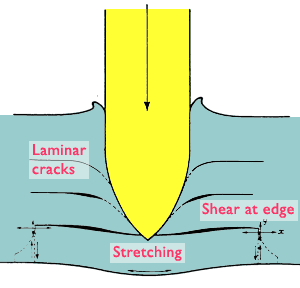
Logo from Scott Cunningham.

Logo from Scott Cunningham.
![]() o far the plate has been regarded as isotropic, but rolled plates seldom are, on account of their tendency to have planes of weakness parallel with the surface. If such planes of weakness are sufficiently pronounced, laminar cracks may form in the plate during penetration and lead to discing failures, or to a modified form of back petalling failure. It is not uncommon for the same plate to fail by plugging in some parts, and by discing or star cracking following lamination in other parts. Since a plug when driven out normally has a length from half to two-thirds of the plate thickness, the event preventing plugging must occur at an early stage in penetration.1
o far the plate has been regarded as isotropic, but rolled plates seldom are, on account of their tendency to have planes of weakness parallel with the surface. If such planes of weakness are sufficiently pronounced, laminar cracks may form in the plate during penetration and lead to discing failures, or to a modified form of back petalling failure. It is not uncommon for the same plate to fail by plugging in some parts, and by discing or star cracking following lamination in other parts. Since a plug when driven out normally has a length from half to two-thirds of the plate thickness, the event preventing plugging must occur at an early stage in penetration.1
This event is the formation of one or more laminar cracks in the layers of plate in front of the projectile, with a consequent reduction in its rigidity. When the plate is laminated in this way it tends to behave as a pile of discs, clamped around their outer edge, and therefore has a lower rigidity than a single diaphragm of the same total thickness. By cutting a partially penetrated plate to examine the condition of the plate material, laminar cracks can be seen in parts of the plate not yet penetrated, ahead of the partially buried head of the projectile.1

The stresses at the edge of a disc, before circumferential cracking starts. Diagram from 1.
The various layers of plate will tend to fail in the same way as a pile of thin plates. They will be bulged in the direction of motion of the projectile and the metal over the nose will be thinned by stretching radially and by compression between the nose of the projectile and the next layer. This process may continue for each successive layer, including the back one, and can give rise to a star cracking failure and finally to complete back petalling.1

An example of discing from a HESH projectile, which looks similar to the discing of RHA by kinetic energy projectiles. From the private collection of Chris Shillito.
On the other hand, since the last layer is less adequately supported than the preceeding layers, it may fail in a different way. The last layer of a laminated plate will bend like a circular diaphragm clamped around the edge and loaded at the centre. If the layer is thick in relation to the diameter of the laminar crack, the tensile stresses at the centre will be small compared with the stresses at the edge, which result from the combination of the radial tensile stress due to bending and the tensile stress perpendicular to the plate face due to the forward thrust on the disc as a whole. In this case a crack is likely to form first around the periphery in the shape of a rough circle, which then breaks off a disc of metal up to several calibres in diameter and usually half a calibre or so in thickness.1
 Failures Peculiar to Cast Armour
Failures Peculiar to Cast Armour
Do you like this web site? Please rate it between one and ten, with ten being the best:
Ratings are submitted to: The Wargames and Military History Search Engine.
Copyright © 2000 David Michael Honner. E-mail: GvA@wargamer.org.